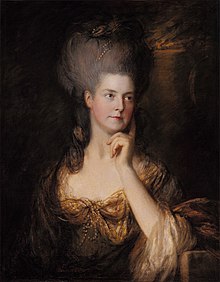|
Maria Walpole
Maria, Duchess of Gloucester and Edinburgh (née Walpole; 10 July 1736 – 22 August 1807) was a member of the British royal family. She was the Countess Waldegrave from 1759 to 1766, as a result of her first marriage to James Waldegrave, 2nd Earl Waldegrave. Her second husband was Prince William Henry, Duke of Gloucester and Edinburgh, whom she married in 1766. Early lifeMaria Walpole was the illegitimate daughter of Sir Edward Walpole and Dorothy Clement. Her grandfather was Robert Walpole, Earl of Orford, considered to be the first Prime Minister of the United Kingdom (1721–41). She grew up at Frogmore House in Windsor, but her parents were not married, and her illegitimate status hindered her social standing despite her family connections.  Countess WaldegraveOn 15 May 1759, she married James Waldegrave, 2nd Earl Waldegrave at the house in Pall Mall of her father, Sir Edward Walpole. The ceremony was performed by Frederick Keppel, the future Bishop of Exeter, and the official witnesses were Sir Edward and his brother, Horace Walpole.[2] The Earl Waldegrave died on 28 April 1763. They had three children:
There is a portrait of Maria in 1764–65, shortly after she was widowed, painted by Sir Joshua Reynolds, in the Dunedin Public Art Gallery. She also commissioned him in 1780 to paint The Ladies Waldegrave, a group portrait of her and Waldegrave's three daughters. After her husband's death in 1763, she was then courted by William Cavendish-Bentinck, 3rd Duke of Portland. She scandalized society when she refused his hand.[5][6][7]  Duchess of Gloucester and Edinburgh  On 6 September 1766, she married Prince William Henry, Duke of Gloucester and Edinburgh, at her home in Pall Mall, London. The Duke was a brother of King George III. The marriage was conducted in secret as the British royal family would not have approved of a marriage between a prince and a widow of non-royal rank and illegitimate birth. They lived at St Leonard's Hill in Clewer, near Windsor, and had three children.
The marriage to a commoner of the Duke's other brother, the Duke of Cumberland, led to the passing of the Royal Marriages Act 1772, which required all the descendants of George II to seek the sovereign's approval before marriage. It was only in September 1772, five months after the passage of the Act, that the King became aware of Prince William's marriage to Maria. As the Act's provisions could not be applied retroactively, Maria and the Duke's marriage was considered valid. Due, however, to the anger of her brother-in-law at the marriage, she was never received at court. References
External links |
||||||||||||||||||||||
